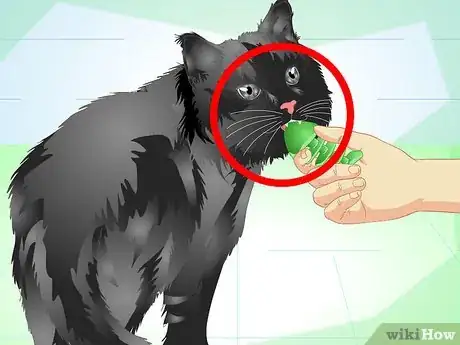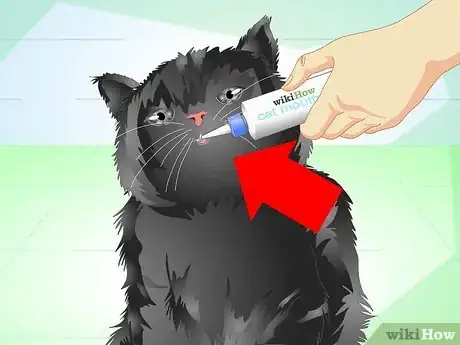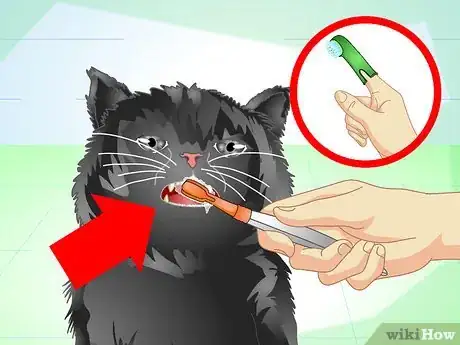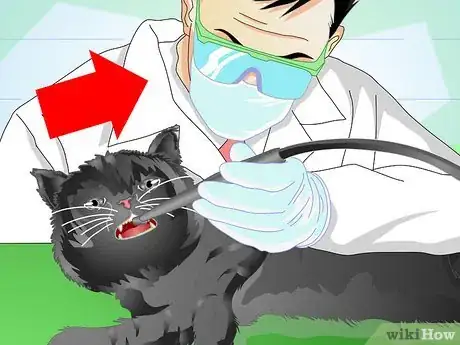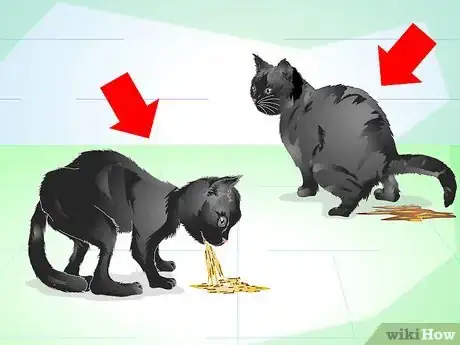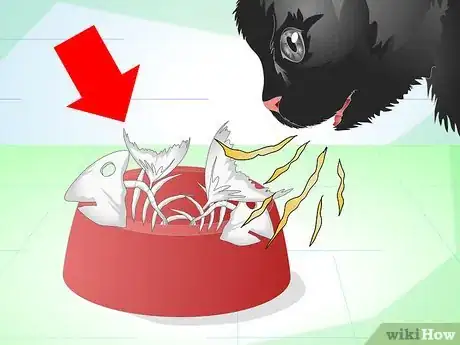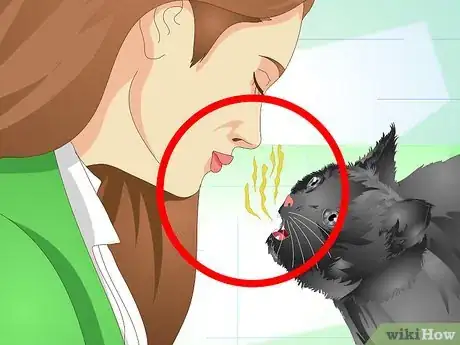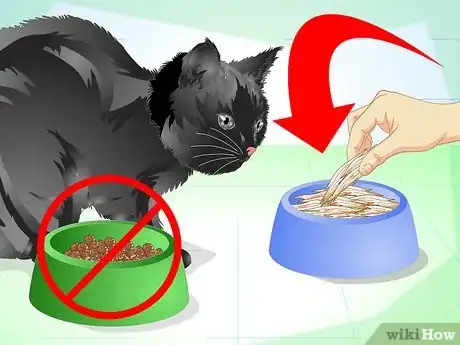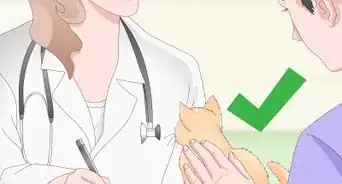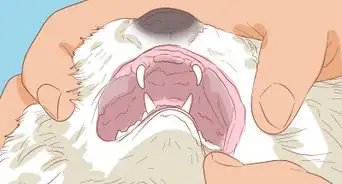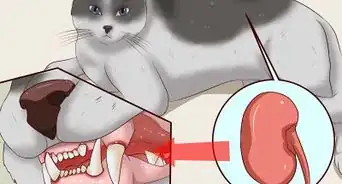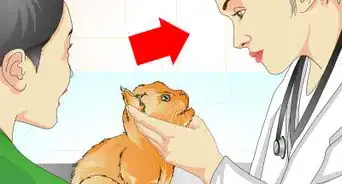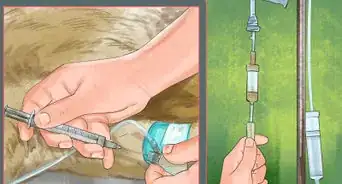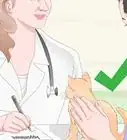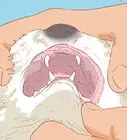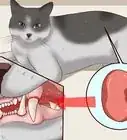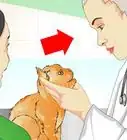This article was co-authored by Pippa Elliott, MRCVS. Dr. Elliott, BVMS, MRCVS is a veterinarian with over 30 years of experience in veterinary surgery and companion animal practice. She graduated from the University of Glasgow in 1987 with a degree in veterinary medicine and surgery. She has worked at the same animal clinic in her hometown for over 20 years.
This article has been viewed 50,203 times.
Good cat breath doesn't need to be perfectly sweet but it should be relatively inoffensive or undetectable. When you snuggle up with your cat you shouldn't recoil from its bad breath. If your cat does have bad breath that makes you shrink away in horror you should try to solve the problem. The most common causes of bad breath are poor dental hygiene, an underlying medical condition, or problems with the cat's diet. All of these problems have solutions that you can easily implement.[1]
Steps
Taking Care of Dental Hygiene
-
1Look in your cat's mouth. You want to determine if your cat's oral hygiene is at fault for the bad breath. Place the cat on a table so that you work at a comfortable height. Make sure the lighting is good so that you can see well. Gently lift the cat's upper lip until you can see the teeth. Look inside the mouth.
- Healthy teeth should be white and not coated in tartar. Tarter has the appearance of yellow deposits on the surface of the teeth, often near the gum line. The gums should be pink with no angry red line of inflammation where the teeth meets the gums. Clean teeth and pink gums make dental disease less likely. However, dirty teeth and inflamed or bleeding gums are indicative of dental disease.
- If you see you cat has dental issues, get it checked by a vet. This is because inflamed gums and bad breath are a sign of bacterial infection and the cat may require medical treatment, such as antibiotics, to settle things down.
- It helps to have a friend who can hold the cat by the shoulders, which leaves both of your hands free to lift the cat's lips.
-
2Give your cat chew toys or treats that will help its oral health. Why not help your cat's health while you make it happy? If your cat likes to chew, give it toys that will massage the gums, floss the teeth, and remove tarter buildup while the cat chews.[2] You can also give your cat treats that are designed to help its dental health.Advertisement
-
3Improve oral hygiene by using a cat-friendly mouthwash. There are various products available, but Hexarinse is recommended. This contains chlorhexidine in a formulation that helps disinfect the mouth for around 12 hours. It helps kill bacteria and stop them from sticking to teeth, thereby reducing the incidence of bacterial infection causing bad breath.
- To use Hexarinse, soak a cotton bud in the solution and wipe it over the outer crown surface of the teeth. Do this morning and evening for optimal preventative dental care.
-
4Brush your cat's teeth. It helps to get the cat used to the tooth brush first, by leaving the brush near their food bowl. For the first few attempts just use water on the brush. Once the cat is accepting the brush in their mouth, use toothpastes designed for use in cats. Do not use human toothpaste as the fluoride level can be damaging when the cat swallows the toothpaste.[3]
- Brush the teeth morning and evening. Use a soft child's toothbrush, a pet toothbrush, or a finger-brush designed for the purpose.
-
5Have your cat's teeth cleaned by a veterinarian. The gold standard is to have your veterinarian perform a dental descale and polish under general anesthetic. This cleans the teeth, gets rid of deposits harboring bacteria, and encourages healthy gums.[4]
- Once the pet has recovered from the procedure you can start brushing its teeth to keep the mouth clean.
-
6Start the cat on a dental diet designed to reduce the formation of tartar. If the tartar is only mild and the gums are not sore, consider switching your cat onto a dental diet. Look for foods approved by the Veterinary Oral Health Council (VOHC) and have their stamp of approval on the bag.[5]
- Approved food usually works by giving a brushing action while it's chewed. Fiber inside each kibble lightly sweep over the cat's teeth when it bites down.
Looking For an Underlying Medical Condition
-
1Assess whether your cat might have a medical condition that is affecting its breath. Several medical conditions can result in bad breath. For example, diabetes is associated with a sickly sweet breath odor, while kidney disease is linked to an ammonia or bleach-like smell.[6]
-
2Watch your cat for signs of ill health. If your cat has bad breath, monitor it closely for tell-tale signs of a problem. Clues that your cat has a health issue include excessive thirst, poor appetite, increased appetite, lethargy, weight loss, weight gain, vomiting, diarrhea, breathing difficulties, an unkempt coat, or changed behavior.
-
3Get your cat checked by a veterinarian. If you are in the least suspicious that your cat is unwell get it checked by a veterinarian. Key to remedying the bad breath is to correct the underlying health issue.[7]
- For diabetes it is likely the vet will either put the cat on a prescription diet or prescribe regular insulin injections.
- For kidney disease the vet will likely put the cat on a prescription diet and on medication to improve renal function.
Assessing Whether Bad Breath is Related to Diet
-
1Consider that the food you are feeding your cat could be causing the problem. If you've checked everything else out and your cat seems fine otherwise, then consider what you're feeding them. For example, offensive fishy breath might just be related to fish in the cat's diet.
-
2Smell your cat's breath at various times of day. You want to figure out if what you are smelling is simply the residue of your cat's last meal. Try smelling your cat's breath right before it eats and then a few minutes after, so that you can compare the smells.
-
3Try changing the cat's diet. Try feeding the cat chicken for a few days and see if the bad breath goes away. If its breath improves on the chicken then reintroduce other foods or flavors of food one at a time. If the cat gets bad breath again don't feed it the last food you reintroduced to its diet anymore.
- Remember that chicken is not a balanced diet in the long term. You need to reintroduce other foods in order to give your cat the nutrition is needs.
References
- ↑ http://pets.webmd.com/cats/guide/bad-breath-cats
- ↑ http://pets.webmd.com/cats/guide/10-steps-cat-dental-health?page=2#2
- ↑ http://www.petmd.com/cat/slideshows/grooming/top-ten-tips-on-how-to-keep-your-cats-teeth-clean
- ↑ http://www.petmd.com/cat/slideshows/grooming/top-ten-tips-on-how-to-keep-your-cats-teeth-clean
- ↑ http://www.vohc.org/AcceptedProductsTable.pdf
- ↑ https://www.vet.cornell.edu/departments-centers-and-institutes/cornell-feline-health-center/health-information/feline-health-topics/bad-breath-sign-illness
- ↑ https://www.vet.cornell.edu/departments-centers-and-institutes/cornell-feline-health-center/health-information/feline-health-topics/bad-breath-sign-illness
About This Article
To get rid of bad cat breath, start by checking its teeth to see if your cat's oral hygiene is causing it. If the teeth are coated in yellow tarter, especially near the gum line, get your cat checked by a vet and schedule a dental cleaning with a professional. Many vets will perform a dental descale and polish under general anesthetic to clean a cat's teeth. You can also give your cat chew toys or special treats to help with oral health. For tips on exploring other causes for the bad breath, read on!

